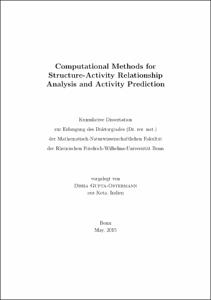Computational Methods for Structure-Activity Relationship Analysis and Activity Prediction

Computational Methods for Structure-Activity Relationship Analysis and Activity Prediction

| dc.contributor.advisor | Bajorath, Jürgen | |
| dc.contributor.author | Gupta-Ostermann, Disha | |
| dc.date.accessioned | 2020-04-21T10:31:54Z | |
| dc.date.available | 2020-04-21T10:31:54Z | |
| dc.date.issued | 05.11.2015 | |
| dc.identifier.uri | https://hdl.handle.net/20.500.11811/6558 | |
| dc.description.abstract | Structure-activity relationship (SAR) analysis of small bioactive compounds is a key task in medicinal chemistry. Traditionally, SARs were established on a case-by-case basis. However, with the arrival of high-throughput screening (HTS) and synthesis techniques, a surge in the size and structural heterogeneity of compound data is seen and the use of computational methods to analyse SARs has become imperative and valuable. In recent years, graphical methods have gained prominence for analysing SARs. The choice of molecular representation and the method of assessing similarities affects the outcome of the SAR analysis. Thus, alternative methods providing distinct points of view of SARs are required. In this thesis, a novel graphical representation utilizing the canonical scaffold-skeleton definition to explore meaningful global and local SAR patterns in compound data is introduced. Furthermore, efforts have been made to go beyond descriptive SAR analysis offered by the graphical methods. SAR features inferred from descriptive methods are utilized for compound activity predictions. In this context, a data structure called SAR matrix (SARM), which is reminiscent of conventional R-group tables, is utilized. SARMs suggest many virtual compounds that represent as of yet unexplored chemical space. These virtual compounds are candidates for further exploration but are too many to prioritize simply on the basis of visual inspection. Conceptually different approaches to enable systematic compound prediction and prioritization are introduced. Much emphasis is put on evolving the predictive ability for prospective compound design. Going beyond SAR analysis, the SARM method has also been adapted to navigate multi-target spaces primarily for analysing compound promiscuity patterns. Thus, the original SARM methodology has been further developed for a variety of medicinal chemistry and chemogenomics applications. | en |
| dc.language.iso | eng | |
| dc.rights | In Copyright | |
| dc.rights.uri | http://rightsstatements.org/vocab/InC/1.0/ | |
| dc.subject.ddc | 004 Informatik | |
| dc.title | Computational Methods for Structure-Activity Relationship Analysis and Activity Prediction | |
| dc.type | Dissertation oder Habilitation | |
| dc.publisher.name | Universitäts- und Landesbibliothek Bonn | |
| dc.publisher.location | Bonn | |
| dc.rights.accessRights | openAccess | |
| dc.identifier.urn | https://nbn-resolving.org/urn:nbn:de:hbz:5n-41874 | |
| ulbbn.pubtype | Zweitveröffentlichung | |
| ulbbn.birthname | Gupta | |
| ulbbnediss.affiliation.name | Rheinische Friedrich-Wilhelms-Universität Bonn | |
| ulbbnediss.affiliation.location | Bonn | |
| ulbbnediss.thesis.level | Dissertation | |
| ulbbnediss.dissID | 4187 | |
| ulbbnediss.date.accepted | 20.10.2015 | |
| ulbbnediss.institute | Zentrale wissenschaftliche Einrichtungen : Bonn-Aachen International Center for Information Technology (b-it) | |
| ulbbnediss.fakultaet | Mathematisch-Naturwissenschaftliche Fakultät | |
| dc.contributor.coReferee | Gütschow, Michael |
Files in this item
This item appears in the following Collection(s)
-
E-Dissertationen (4458)




